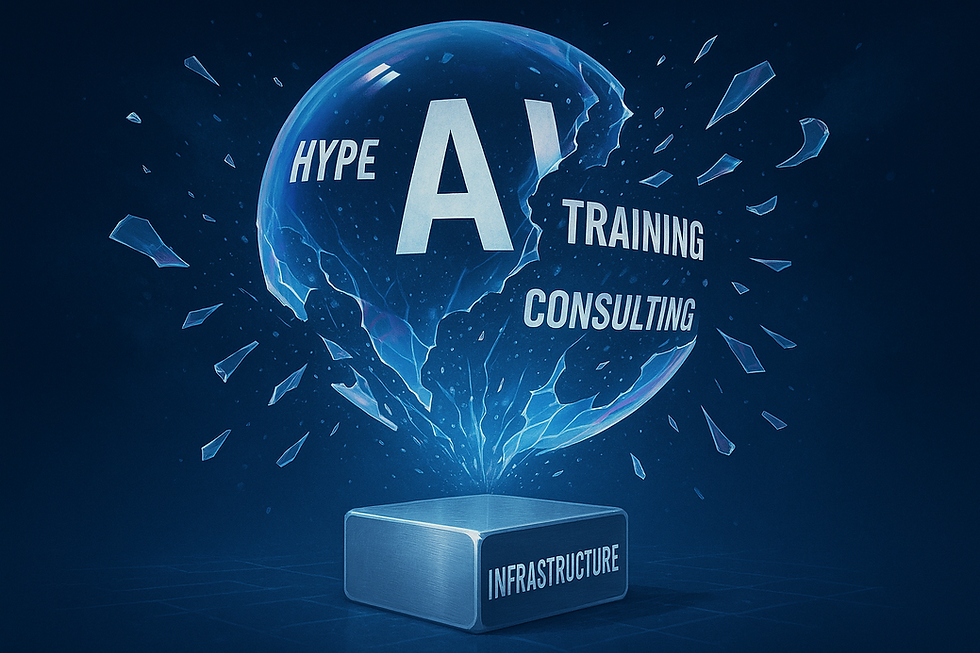Should You Launch an AI-Enabled Business Ahead of the UBI Wave?
- Rich Washburn

- Aug 4, 2024
- 4 min read

As artificial intelligence (AI) reshapes the economic landscape, the potential for wide-scale job displacement grows, making Universal Basic Income (UBI) and Universal Basic Compute (UBC) more relevant than ever. While full-scale UBI implementations remain in the testing phase, the time is now to get ahead of these changes by starting an AI-powered business. The impending shift in the social contract means those who act now can capitalize on what looks to be the next gold rush.
Seizing the Moment: Insights from Altman's Study
Sam Altman, CEO of OpenAI, recently conducted a study on UBI, providing $1,000 per month to a thousand low-income individuals over three years. The results were telling: recipients primarily spent the money on essentials such as food, rent, and transportation, while also assisting family and friends or saving. Despite working slightly less—about one hour less per week—recipients experienced reduced financial stress, though this relief was temporary, resurfacing after two to three years.
Altman’s findings challenge the notion that free money leads to idleness and highlight the potential of UBI to support basic needs and reduce immediate financial anxieties. However, this only scratches the surface of the opportunities that lie ahead.
AI integration into various industries poses a substantial threat to traditional employment but also opens new avenues for entrepreneurial ventures. Tony Robbins emphasizes the inevitability of job displacement, particularly in sectors like transportation and agriculture, which could see millions of jobs disappear. He argues for the necessity of UBI but also stresses the importance of finding new sources of meaning and purpose through continuous retooling and adaptation.
Former U.S. Labor Secretary echoes these sentiments, highlighting that not just routine but professional jobs are at risk. The potential loss of middle-class jobs due to AI’s efficiency could lead to significant social and political challenges. A UBI could act as a buffer, ensuring people have enough money to participate in the economy, thus maintaining demand for goods and services produced by an increasingly automated workforce.
While UBI focuses on providing financial support, the concept of Universal Basic Compute (UBC) is emerging as a complementary idea. UBC proposes guaranteed access to computational resources, allowing individuals and businesses to harness AI and advanced computing power without prohibitive costs. This democratization of technology could foster innovation and equip people with tools to adapt to the new economic landscape.
David Shapiro, a prominent AI thought leader, underscores the experimental nature of UBI. Various cities across the U.S. are piloting UBI programs, aiming to understand its broader implications. Despite these promising experiments, some states, particularly those with conservative ideologies, have moved to ban publicly funded UBI initiatives, reflecting a deep-rooted belief in minimal government intervention.
The debate around UBI touches on the changing nature of the social contract in America. Historically, the promise of hard work leading to prosperity has been a cornerstone of the American Dream. However, with AI narrowing the gap between labor supply and demand, economic compaction is eroding this promise. UBI is seen as a modern response to this shift, aiming to provide a safety net in a landscape where traditional jobs are becoming scarce.
Where to Start: A Path Forward
The implementation of UBI and UBC provides a foundational safety net—think of it as a "BASE" income. This is the perfect moment to leverage these resources and get ahead of the potential gold rush these changes will create. Here’s an example roadmap to help you:
Step 1: Start with the Problem
The foundation of any successful business is solving a real problem. Focus on identifying pain points through consulting and observing industry needs. Engage with potential customers and industry professionals to understand recurring problems. Many successful companies started by addressing specific client issues before scaling their solutions.
Step 2: Build a Prototype
Before investing in development, create a prototype to visualize your solution. This can be a simple wireframe or a more advanced clickable prototype. Tools like Balsamiq, Figma, and InVision can help simulate the user experience. Validate the prototype with potential users to refine functionality and user experience.
Step 3: Validate Your Product
Validation is critical to ensure there's a market for your product. Get actual commitments, often monetary, from potential customers before full-scale development. Utilize crowdfunding platforms to gauge interest and secure funding based on prototype demonstrations.
Step 4: Build Your MVP
Develop a Minimum Viable Product (MVP) with constrained features that can be delivered within three months. This approach prevents prolonged development cycles and allows for quicker market entry and iteration. Use platforms like Upwork to find skilled developers and provide them with detailed wireframes.
Step 5: Collect Customer Feedback
Engage directly with users to understand their needs and pain points. Schedule regular sessions to gather detailed feedback from users and continuously refine the product based on this feedback.
Step 6: Generate Demand
Effective demand generation strategies are crucial for growth. Collaborate with industry influencers and organizations to access large customer bases quickly. Develop valuable content that attracts and engages potential customers, and use targeted advertising to raise awareness and drive sign-ups.
Step 7: Find a Growth Hack
Identify unconventional methods to acquire customers that provide an edge over competitors. Start with manual outreach to validate effectiveness, then automate processes to scale.
This just an example of strategic steps, aspiring entrepreneurs can use to help navigate the startup complexities of building a business from scratch. Remember, the key lies in solving real problems, validating demand, and continuously iterating based on customer feedback.
#UniversalBasicIncome #AIRevolution #EconomicStability #DigitalTransformation #FutureOfWork #SocialEquity #JobDisplacement #UBI #AIImpact #TechPolicy




Comments